The first of Wine Lister’s partner critics to release scores for the latest Burgundy vintage, Neal Martin’s assessment (for Vinous) provides initial insight into some of the top en primeur picks in 2020.
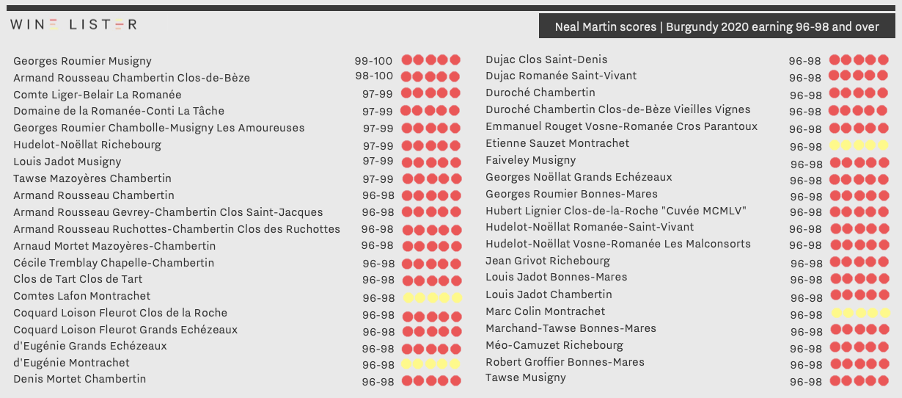
What do we know about Burgundy’s 2020 vintage so far?
2020 will be remembered as a year that saw some of the earliest harvest dates ever recorded in Burgundy, with several of the region’s producers picking as early as 12th August. Though following the pattern of recent vintages marked by warm and dry growing seasons, the threat of drought was partly alleviated by significant rainfall during the winter months through to spring, which ensured water reserves were replenished ahead of the heat. Some Pinot Noir producers nonetheless saw a drop in yields, particularly on sites with poorer soils, and thus restricted water retention ability.
Dry conditions during ripening minimised the threat of disease and mildew, which was valuable for the healthy growth of red and white grapes. Despite the earlier harvest, the grapes saw excellent ripening and phenolic development, while high levels of evaporation concentrated sugars, flavours, and acidity.
The top-scorers
Compared to the 19 wines that Neal Martin awarded 96-98 and above last year, there are an impressive 40 wines within the same parameter for the 2020 vintage. While there were no wines that earned a potential perfect score in 2019, Georges Roumier’s Musigny and Armand Rousseau’s Chambertin Clos-de-Bèze receive 99-100 and 98-100 points respectively in 2020. Neal Martin notes that the top-scoring reds of the vintage all share an excellent acidity, which “lends the 2020s a sense of brightness”.
Also faring notably well, Comte Liger-Belair’s La Romanée, Domaine de la Romanée-Conti’s La Tâche, Georges Roumier’s Chambolle-Musigny Les Amoureuses, Hudelot-Noëllat’s Richebourg, Louis Jadot’s Musigny, and Tawse’s Mazoyères Chambertin earn scores of 97-99.
Whites worth trying
Four whites hailing from Montrachet appear on the list, with offerings from Comtes Lafon, Domaine d’Eugénie, Etienne Sauzet, and Marc Colin each earning a score of 96-98. Neal Martin describes mineral notes across each, having written that this was one of the great attributes of the top whites in the vintage – especially across those grown on more “calcareous soils” akin to that which Montrachet boasts. Following the trend of white burgundy producers using less new oak, Marc Colin uses only old oak barrels for the first time in this vintage, while Comtes Lafon matured Montrachet in one-third new oak instead of 100%.
Discover Neal Martin’s full list of Burgundy 2020 scores here. Watch this space for further Burgundy 2020 score updates from Wine Lister’s partner critics, JancisRobinson.com, and specialist Burgundy critic, Jasper Morris MW.
22 Champagnes for 2022
Considering the latest industry insights shared in our annual end of year study, Wine Lister explores an eclectic range of Champagne MUST BUYs worth celebrating. With an initial selection made by our proprietary recommendation algorithm, based on quality and value within the category, we have singled out some top picks to pop open as we ring in 2022.
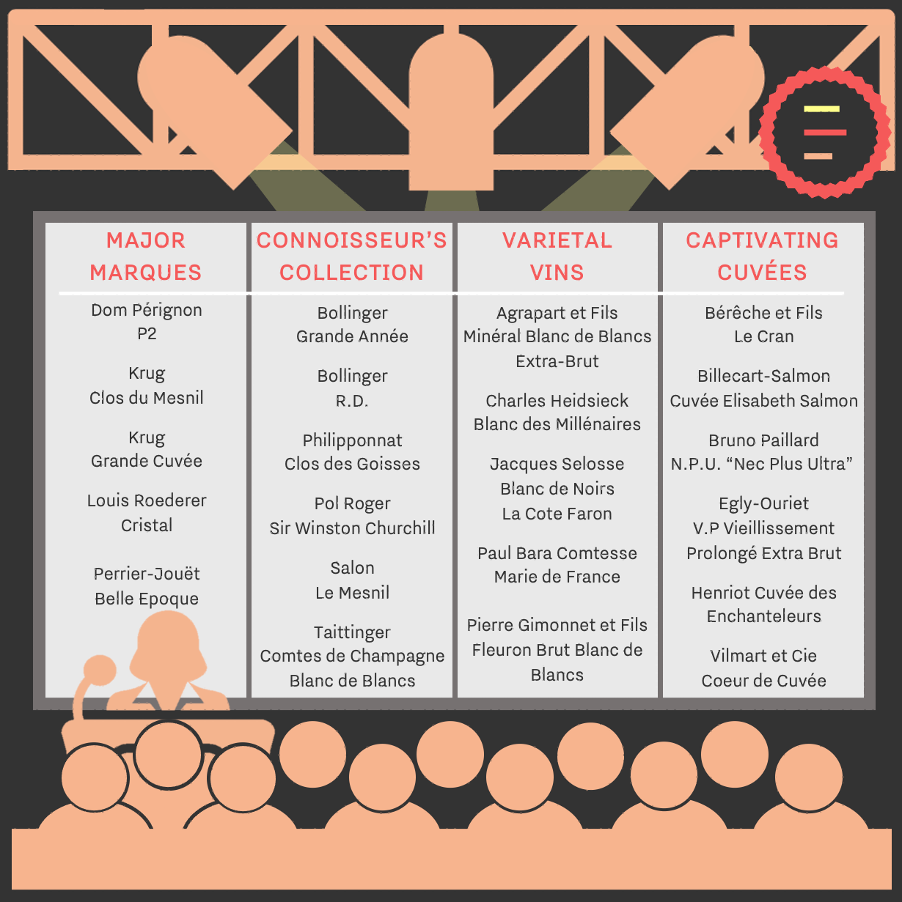 Wine Lister Leagues 2021: New Year’s Eve Champagne MUST BUYs (p. 17)
Wine Lister Leagues 2021: New Year’s Eve Champagne MUST BUYs (p. 17)
With demand for Champagne reaching record heights this year, Wine Lister’s latest Leagues explore a selection of top bottles to take you into 2022, featuring a variety of styles and price points across four categories: Major Marques, Connoisseur’s Collection, Varietal Vins, and Captivating Cuvées.
What Champagne should I buy?
Major Marques
A selection of Champagne’s strongest brands, the list of Major Marques features Krug’s Grande Cuvée and Clos de Mesnil alongside Louis Roederer’s Cristal, Perrier-Jouët’s Belle Epoque, and Dom Pérignon’s P2. The latter is considered a top Investment Staple, receiving recognition from the global fine wine market as a relatively stable and liquid option (discover our list of 2021 Investment Staples on p. 16).
Connoisseur’s Collection
Favourites among the trade and fine wine lovers alike, these insider icons include Philipponnat’s Clos des Goisses, Pol Roger’s Sir Winston Churchill, Salon Le Mesnil, and Taittinger’s Comtes de Champagne. Bollinger is featured twice in the line-up with its Grande Année and R.D. cuvées; with a distinguished history dating back to 1829, the estate has the only two vineyards in Champagne to remain phylloxera-free throughout the late 19th-century epidemic.
Varietal Vins
Our selection of Blanc de Blancs worth seeking out include Agrapart et Fils Minéral Extra-Brut, Pierre Gimonnet et Fils Fleuron Brut, and Charles Heidsick’s Blanc des Millénaires. Produced only in exceptional years, there have been four vintages of Blanc des Millénaires released since its inaugural 1983 vintage, with the cuvée spending a minimum of fifteen years maturing in the heart of Charles Heidsieck’s 2000-year-old underground chalk cellars (a UNESCO world heritage site) before release.
Made exclusively from Pinot Noir, Jacques Selosse’s La Cote Faro and Paul Bara’s Comtesse Marie de France also feature in the MUST BUY selection. A seventh-generation family business, Champagne Paul Bara is one of the few grower producers in Bouzy – a village widely regarded as amongst Champagne’s top sites for the production of Pinot Noir.
Captivating Cuvées
Sure to impress during the festive season, our list of Captivating Cuvées includes key grower producers Bruno Paillard, Bérêche et Fils, Vilmart et Cie, and Egly-Ouriet, whose featured wines each offer relative value within the selection of Champagne MUST BUYs. Henriot’s Cuvée des Enchanteleurs and Billecart-Salmon’s Cuvée Elisabeth Salmon complete the list – the latter being the only rosé Champagne featured, comprising a blend of around 50% Chardonnay and 50% Pinot Noir, of which 10% is vinified as red wine and incorporated into the final blend.
For further analysis on quality consistency, increased popularity, and a list of 2021s most compelling wines, download the Winer Lister Leagues 2021 here.
The insider’s guide to fine wine trends, and the most compelling wines to watch
Wine Lister has released its second annual Wine Leagues, celebrating some of the top-performing wines and producers in today’s new and much-diversified fine wine era. Informed by an in-depth trade survey with leading industry figures, the report provides a 360° view of those regions, producers, and wines that have seen strides in quality, popularity, economic promise, and more in 2021.
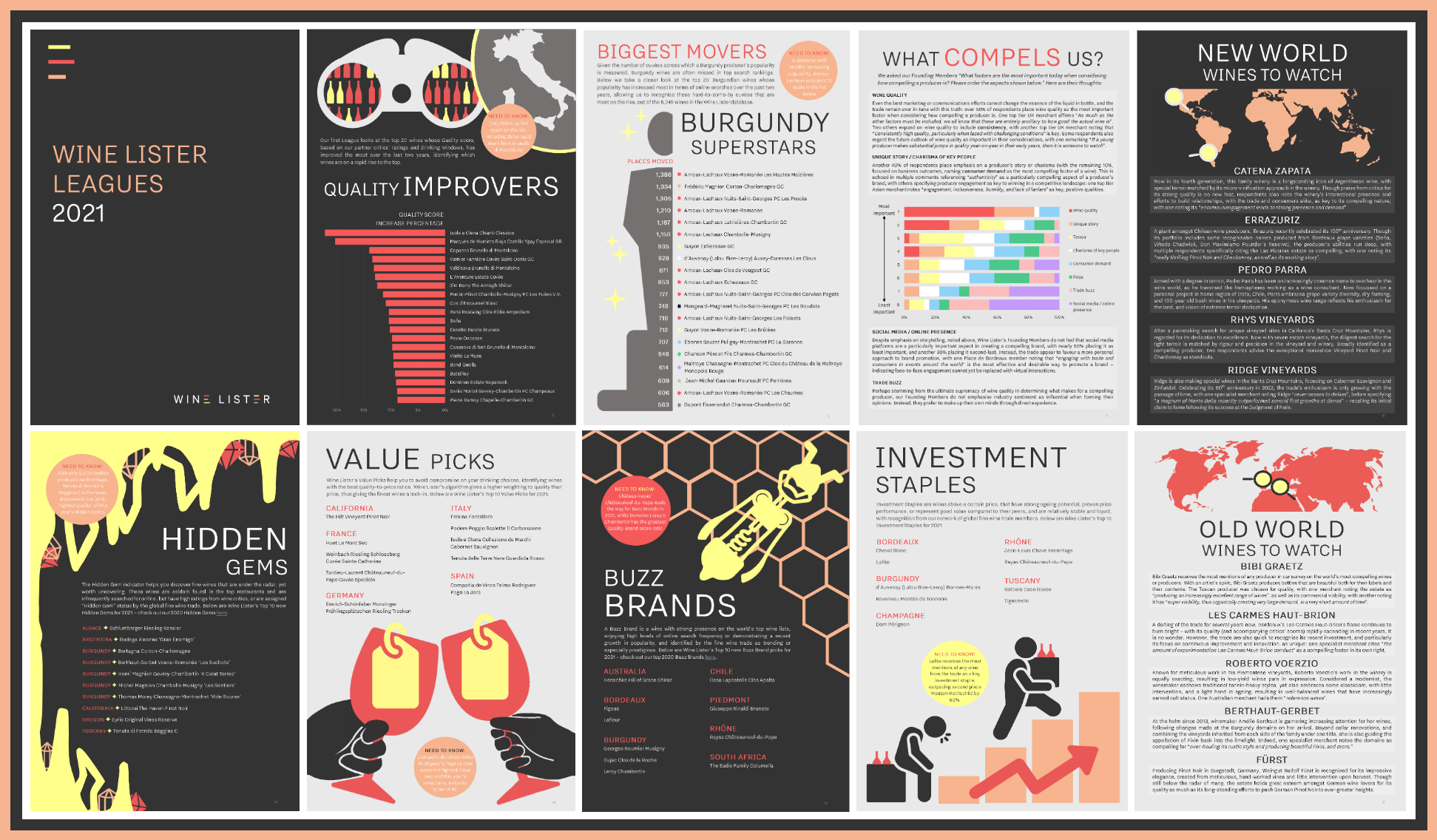
Wine Lister’s annual in-depth survey sees our expert panel of 47 CEOs, MDs, and wine department heads share their insight on some of the fine wines to have on your radar, as we ask them:
“What are the most compelling wines and producers in the market today?”
Respondents singled out 188 wines and producers collectively, that span no less than 20 major regions. Within the list, our team identifies Bibi Graetz, Les Carmes Haut-Brion, Roberto Voerzio, Berthaut-Gerbet, and Fürst as wines to watch in the Old World, whilst calling out the New World wonders of Catena Zapata, Errazuriz, Pedro Parra, Rhys Vineyards, and Ridge Vineyards.
The report also includes rankings across:
- Biggest quality improvers, which show impressive movement from Italy (occupying five places in the list of the top 20 by Quality score progression), with Isole e Olena Chianti Classico leading the pack
- Best search rank movers, wherein Bordeaux represents eight of the top 20 wines whose popularity has increased most in terms of online searches (including Smith Haut Lafitte, Domaine de Chevalier, Figeac, and Léoville Poyferré)
- Burgundy superstars, focusing on popularity movements from the trade’s darling region – Arnoux-Lachaux features 10 times in the list of top 20 Burgundian wines whose online searches have increased the most over the last two years
- Wine Lister’s top-10 recommendations per Wine Lister Indicator; Hidden Gems, Value Picks, Buzz Brands, and Investment Staples in 2021
For the full analysis, download your free copy of Wine Lister’s 2021 Leagues here.
The balancing act
Following our recent report on Bordeaux’s 2021 harvest, Wine Lister now turns to Tuscany to find out more about its 2021 vintage so far, with insight from 10 top producers across the region
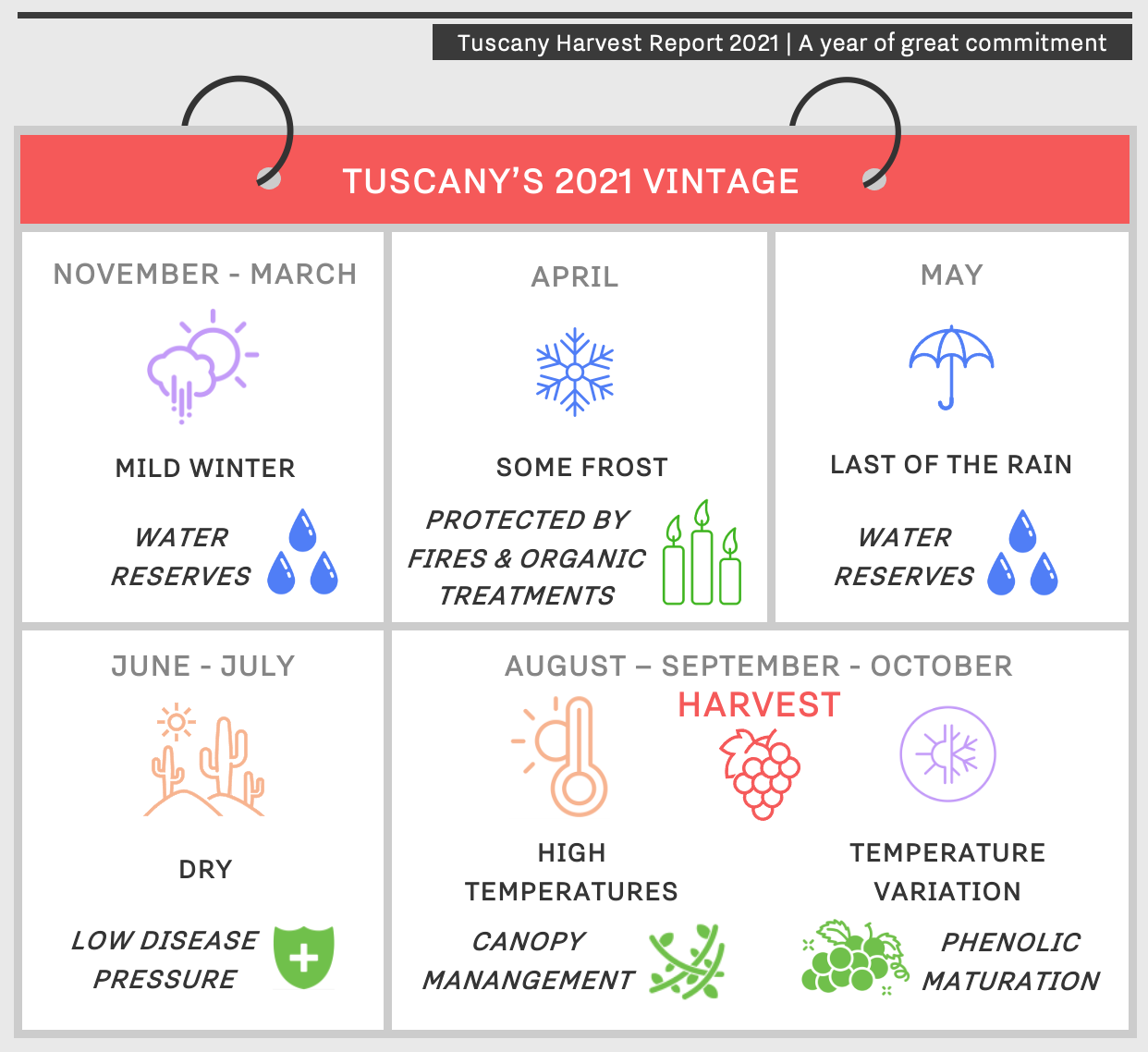
Tuscany’s 2021 growing season has been characterised as a year of climatic extremities, including a mild and rainy winter, the onset of frost in spring, persistent drought in summer, and ending in ideal harvest conditions. In a show of resilience and adaptability, producers were able to reap the benefits of acute weather patterns – with the potential consequences of drought lessened by the groundwater reserves accumulated in winter, and dry conditions reducing disease pressure over the summer.
What can we expect from Tuscany’s 2021 vintage?
Multiple methods to fight frost
- Properties lit fires in the vineyards to circulate warm air and reduce the risk of frost. Owner of IPSUS, Giovanni Mazzei tells us that the technique successfully “increased the temperature up to 2˚C” across the IPSUS vineyards, protecting the vines from damage
- Several producers used organic treatments to improve vine health following the frost, including Argiano, whose Sales Manager, Riccardo Bogi tells us that “brown algae allowed the plants to stabilise and respond as quickly as possible to the loss of sprouts”
- Frost was particularly prevalent in low-lying coastal regions, with Ornellaia’s winemaker, Axel Heinz witnessing “damages limited to a few lower altitude vineyards, without significant impact on production”. Le Macchiole’s Commercial Director, Gianluca Putzolu tells us that the estate also implemented “organic spring fertilization” to combat frost that hit “some, but fortunately very few vineyards”
Water reserves
- Rainfall during winter accumulated important water reserves at both Argiano and Romitorio, encouraging a good state of hydration ahead of the growing season
- Some high-altitude properties also saw snowfall during winter that, when melted, “percolated the soil with water”, according to Romitorio’s owner, Filippo Chia
- Abundant rainfall in May allowed plants to survive the hot summer, with Riccardo confirming that this was “essential” for Argiano’s 2021 vintage, “since after that, there was no rain until the beginning of October”. Similarly, Fèlsina’s owner, Giovanni Poggiali tells us of some “rainy days in June”
Sun and heat exposure
- “The management of the canopy needed to be delicate and precise to avoid sunburns”, explains Avignonesi’s COO and Agronomist, Alessio Gorini, who also explained that the use of high-tech sorting equipment allowed them “to completely remove any berries withered or raisined by the sun”
- Organic treatments were adopted to protect the vines from sun exposure, such as the use of “kaolin” at Tenuta San Guido. General Director, Carlo Paoli explains this to be “a natural substance that we have been using for many years in hot vintages”, which helps to reduce the vines’ susceptibility to scorching
- A broad diurnal range across several high-altitude estates encouraged balance despite the hot summer, with Castiglion del Bosco’s winemaker, Cecilia Leoneschi noting that the difference of more than 10°C between day and night temperatures was a “real blessing”
 Teamwork amongst Tuscan vines: IPSUS (left), Tenuta San Guido (middle), Ornellaia (right)
Teamwork amongst Tuscan vines: IPSUS (left), Tenuta San Guido (middle), Ornellaia (right)
A remarkably healthy vintage
- Lack of rain throughout June and July minimised disease pressure; Filippo confirmed that “from a mould and disease standpoint, it was actually one of the healthiest vintages [Romitorio] has seen”, thanks to the “dry summer”. Giovanni echoes this sentiment for IPSUS, while Gianluca reiterates there were “no particular problems” at Le Macchiole, despite the risk of powdery mildew – a more common problem for the Bolgheri area
Striking when the time was right
- For many estates, harvest timing was essential, with Alessio and the Avignonesi team similarly conscious of “avoiding over-ripening on such concentrated grapes”
- Producers had to be particularly reactive to picking dates, explains Axel – whose 2021 harvest “required great skill” in planning, eventually leading to a “very compact harvest completed in one month, instead of the usual 40 days”. Owner of Tua Rita, Giovanni Frascolla similarly characterised 2021 as a “lightning harvest”
Balanced acidity
- “Powerful dark structure – we normally see this with low acid, but this has high acid” recounts Filippo from Romitorio’s latest tasting of the blend
- First impressions show “bright aromatics and, luckily high acidities to keep everything in balance”, at Ornellaia, with Axel describing a “rich and concentrated” wine, “with soft tannins”
- “Grapes matured in a homogeneous way and with a perfect balance of acidity and PH” explains Carlo at Tenuta San Guido
Working around the clock
Wine Lister catches up with nine top producers from Bordeaux’s Left Bank to find out more about their 2021 harvest, and to hear their early evaluation of the vintage
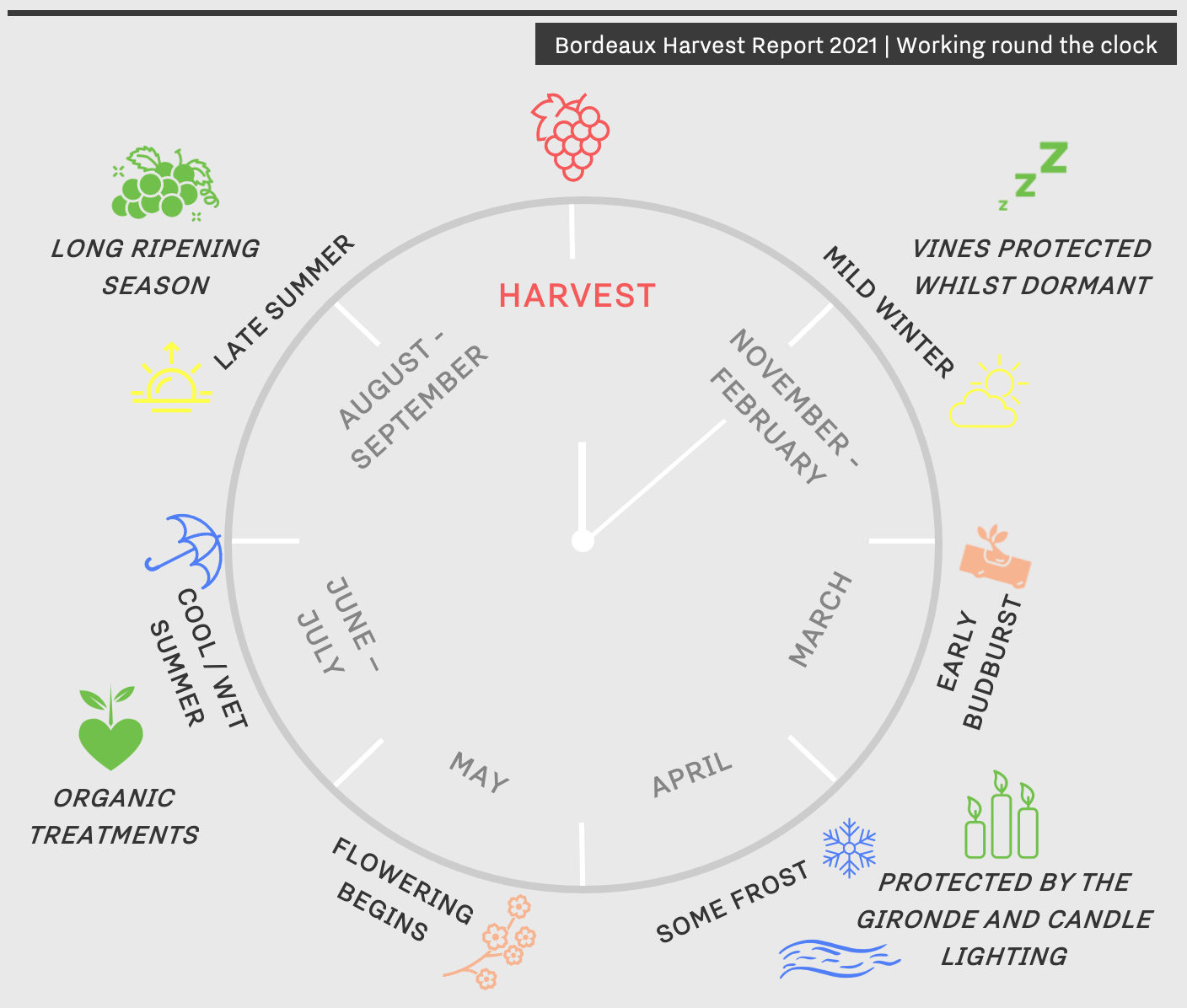
Bordeaux’s 2021 vintage required patience and commitment. Producers worked around the clock to protect their vines – some were threatened by frost, others by disease pressure over the cool and wet summer, but all brought their respective teams together, facing the hand that Mother Nature dealt them with the best experience and techniques the modern wine world has to offer.
What do we know about Bordeaux’s 2021 vintage so far?
Frost protection
- Several producers were protected from the April frost due to their proximity to rivers – just 600m from its banks of the Gironde, d’Issan vineyards escaped damage, according to owner, Emmanuel Cruse. Similarly, Vineyard Manager, Nicolas Dudebout tells us that Malescasse were “naturally shielded” by their privileged positioning near the Garonne
- Other properties were well-equipped to fight the frost proactively, with Smith Haut-Lafitte’s owner Florence Cathiard confirming that a combination of “Valerian decoction (Valeriana officinalis plant root used for its restorative properties), and candles” protected their vines
Organics against disease pressure
- The cool and wet start to summer left some producers vulnerable to disease pressure: Florence told us that Smith Haut-Lafitte reacted to the threat of mildew using “copper mixed with phytotherapy decoctions of horsetail, nettle, wicker, and comfrey”
- “We take the best of both worlds” at Larrivet Haut-Brion, describes Cellar Master, Charlotte Mignon. She explains that the team were “reactive to fighting mildew attacks”, using biocontrol to facilitate the sustainable use of “organic, biodynamic, and conventional solutions [as] necessary”
Late summer ripening
- Late summer sun in August and September created favourable conditions for Merlot, an early-ripening grape variety that is notoriously challenging in hotter temperatures. Cos d’Estournel’s Technical Director, Dominique Arangoïts, found their Merlot to be “remarkably enticing, fruity, and rich with a very noble expression”
- Slower ripening of Cabernet Sauvignon grapes encouraged good phenological maturity: During his last harvest at Lafon-Rochet, Basile Tesseron tells us that, following early pre-harvest berry tastings, the grapes fortunately progressed beautifully in the last few weeks, eventually becoming “more expressive, and well-balanced”
- After a trio of warmer vintages, Charlotte notes that the Cabernets at Larrivet Haut-Brion achieved “perfect ripeness”, thanks to a longer growing season, and sunshine in late-August right up until harvest in October, which gave grapes with “a very good state of health”
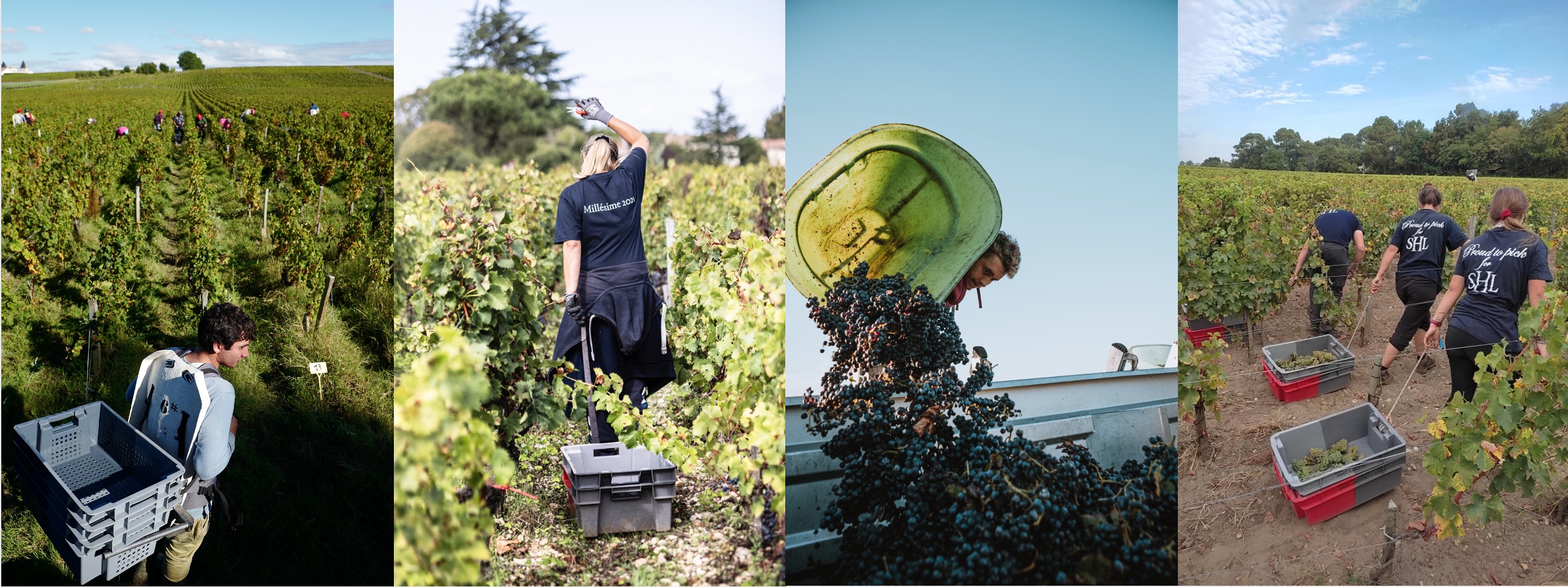 A snapshot of this year’s harvest: Lafon-Rochet (far left), Palmer (middle left), d’Issan (middle right), and Smith Haut-Lafitte (far right)
A snapshot of this year’s harvest: Lafon-Rochet (far left), Palmer (middle left), d’Issan (middle right), and Smith Haut-Lafitte (far right)
Lower alcohol content
- “Low levels of sugar have resulted in a lower alcohol content” in Cos d’Estournel’s Cabernet Sauvignon this year, with Dominique identifying “a magnificent intensity and freshness” and the characteristics of “the most elegant, sophisticated wines”
- “This harvest will be marked by an alcohol-acidity balance, completely different from previous years”, observes Haut-Brion’s Technical Director, Jean-Philippe Masclef. Their Cellar Master, Florence Forgas associates “moderate alcoholic degrees” as being “closer to much older vintages”
- A cooler vintage compared to the previous three resulted in “pure fruit, and a very interesting density” in Palmer’s 2021 grapes, according to Thomas Duroux
Good things to come
- “Merlots are softer than usual and the Cabernets more compact” according to Cantenac Brown’s winemaker José Sanfins, who hopes for an overall blend that is “dense and complete, with fine and elegant tannins”
- Favourable weather during harvest, including “morning temperatures of around 4˚C, preserving freshness across all grape varieties” at d’Issan
- Bordeaux’s whites also boast vibrancy in 2021, with Charlotte noting “freshness and tension” with “aromatic clarity” from Larrivet Haut-Brion’s Sauvignon Blanc and Sémillon grapes
New World icons join top Tuscan wines for the first week of releases
A trading system used to distribute Bordeaux wines for almost 800 years, the Place de Bordeaux has, in more recent years, provided an international stage for many wines originating beyond its own borders. The first non-Bordeaux bottle to join La Place in 1998 was Almaviva, followed by Opus One in 2004, Masseto in 2008, and Solaia in 2009. Over the past decade, a further flurry of eminent estates from around the world have joined the distribution network, and together they form a campaign of new vintage releases every September.
 Seña and Chadwick owner, Eduardo Chadwick, and daughter, Magui
Seña and Chadwick owner, Eduardo Chadwick, and daughter, Magui
Which fine wines were released through the Place de Bordeaux this week?
South American superstars
Clos Apalta 2018 kicked off this year’s campaign on Tuesday 31st August, at £71.50 per bottle (in-bond). At this year’s CVBG London tasting at Berry Bros. & Rudd, Wine Lister enjoyed the elegance of the latest release, which boasted red fruits, pepper, and a hint of smokiness on the nose, and a fresh acidity and energy on the palate. Another vintage that adheres to the estate’s impressive quality consistency over the past five years, demand for the 2018 is further encouraged by Clos Apalta’s status as one of Chile’s leading wine brands.
Across the Andes, Catena Zapata released its 2018 vintage on Wednesday 1st September, with Nicolàs Catena Zapata entering the market at £53 per bottle (in-bond). Having gained 96 points from Joaquín Hidalgo for Wine Lister partner critic Vinous.com, the latest vintage achieves its highest ever-score from the critic outfit. He calls it “breathtaking”, with “layers of aroma, beginning with black currant and moving on to intense, precise notes of lavender and mint along with hints of black tea, sage and cigar box”.
Released yesterday (Thursday 2nd September) at £80 per bottle (in-bond), Seña 2019 was the product of a “long, stable ripening season”, according to owner, Eduardo Chadwick. Tasting with Wine Lister on Zoom, he explains that while “January did begin warmer than usual, summer in March was cooler than normal”, retaining freshness. Indeed, our team found the 2019 to be beautifully balanced, perfumed with muddled berries, sweet spice, and promising complexity of cherries and rustic earth, with satin tannins, on the palate. Supplemented by its high quality, the special-edition 25th-anniversary bottling should stimulate interest in Seña’s latest offering.
Describing Viñedo Chadwick 2019 as “one of the best recent vintages”, Eduardo tells us that, as ever, the character of the wine is shaped by the estate’s altitude. He explains that the great diurnal range throughout the warm growing season allowed freshness, encouraging what Wine Lister found to be both remarkable lift and flavour intensity, with aromas of iris, fresh herbs, and blackberry. Released onto the market at c.£230 per bottle, the 2019 was awarded 99 points by James Suckling, who echoes the sentiment that the wine is “refined, yet powerful”.
South African sweetness
On Wednesday 1st September, Klein Constantia released its Vin de Constance 2018 at £41 per bottle (in-bond). Wine Lister tasted the latest release on Zoom alongside Winemaker, Matt Day, and found notes of citrus and stone fruits complemented with notes of ginger on the nose, complete with a generous and balanced palate with a lightness and freshness that defies the stereotypes of “sweet wine”. Matt told us he believes the vintage represents an embodiment of his “fine-tuned” craft, which also coincided with “a perfect [growing] season”, encouraging the continuation of its positive quality trajectory this year. Indeed, the latest release (as yet not scored by any Wine Lister partner critics) gains 98 points from James Suckling in his most recent tasting.
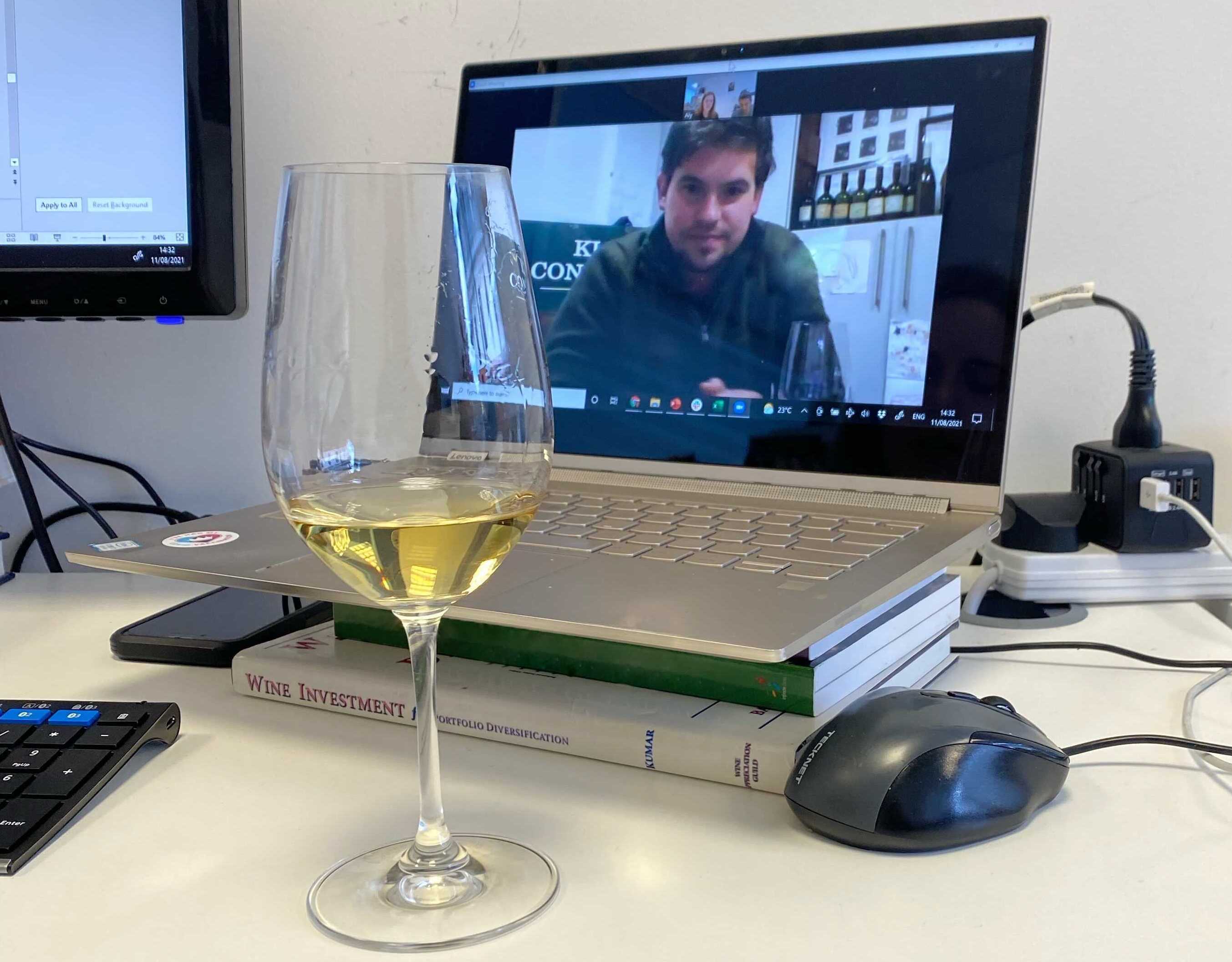 Tasting Vin de Constance 2018 alongside Klein Constantia Winemaker, Matt Day
Tasting Vin de Constance 2018 alongside Klein Constantia Winemaker, Matt Day
Top Tuscan offerings
Bibi Graetz’s Testamatta and Colore 2019 entered the market yesterday (Thursday 2nd September), at £73 and £180 per bottle (in-bond), respectively. Marking its 20th anniversary vintage, both wines feature special-edition bottles designed by artist turned vigneron, Bibi Graetz, with colour and text applied directly onto the glass. Wine Lister was particularly impressed with Colore 2019, which boasted a perfumed nose of violets, frangipane, and crushed berries, following through to a vibrant and juicy palate with silky tannins.
Wines likely to be released through the Place de Bordeaux next week include: Opus One 2018, Overture NV, Masseto 2018, Massetino 2019, Latour 2005, Almaviva 2019, Epu 2019, Cheval des Andes 2018, Solaia 2018, and Beaucastel Hommage à Jacques Perrin 2019.
The best bottle for your budget
Considering the best of white Burgundy MUST BUYs across five different price points, these potential picks gain high WL scores and are all approaching or within their drinking window parameters. Wine Lister’s MUST BUY algorithm produces initial recommendations through considering a wine’s quality and value within its vintage and appellation.
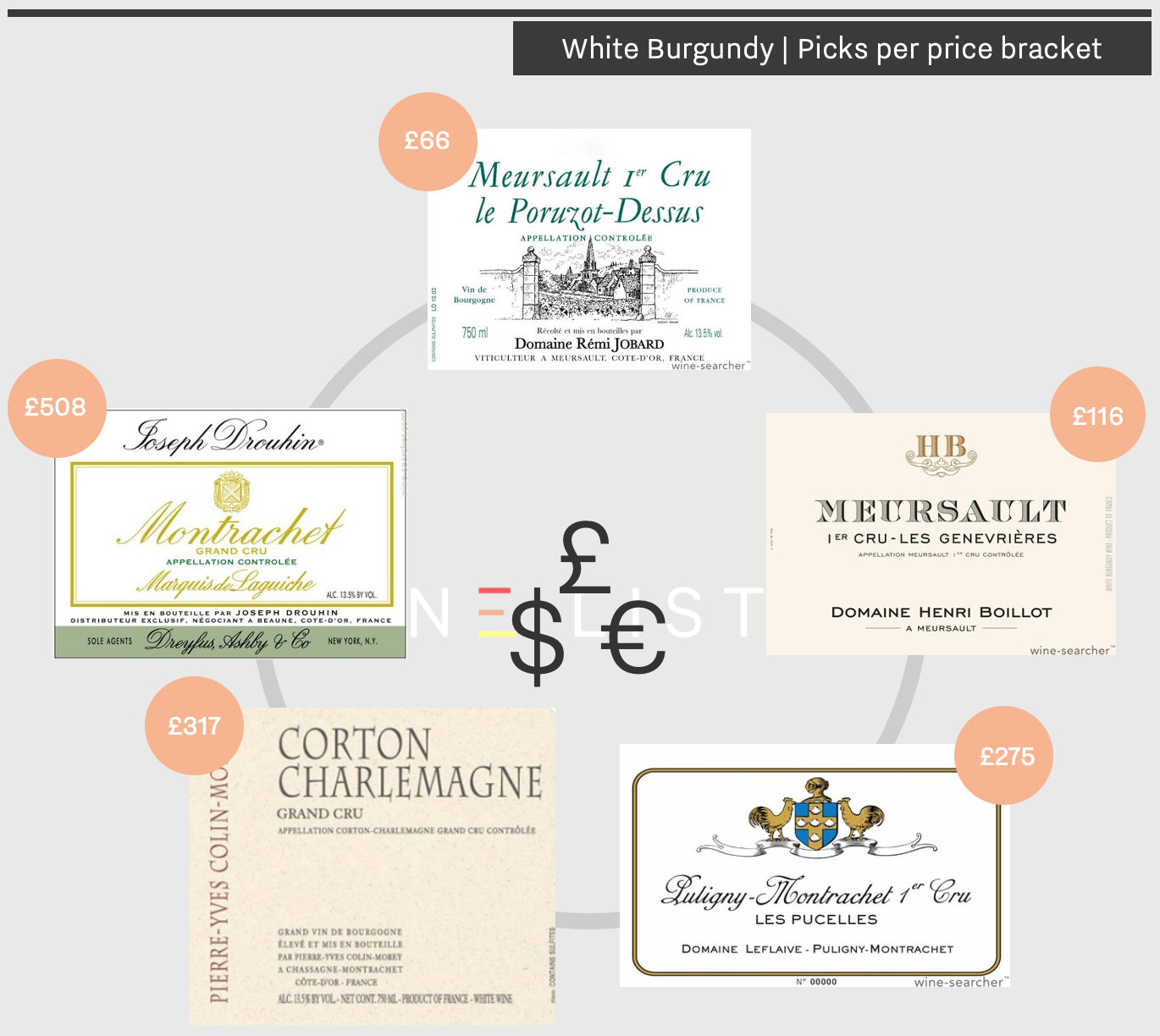 White burgundy MUST BUY picks per price bracket (per bottle, in-bond)
White burgundy MUST BUY picks per price bracket (per bottle, in-bond)
Which are the best white Burgundy wines for my budget?
Notorious for housing wines of high quality with equally high demand, Burgundy has seen some extreme price rises over the last few years. Below we explore top white Burgundies with availability across a range of prices.
With a history of winemaking in his family dating back to the 15th century, Rémi Jobard took over his namesake estate from his father in 1996, and has since overseen many developments. As well as converting to an organic practice in 2008 (and gaining certification in 2011), Rémi introduced cover crop growth across his seven vineyards to encourage the 60+ year old vines to grow deeper to find nutrients. Harbouring a naturally limited yield through cordon-pruning, Rémi Jobard produced just 2,700 bottles of Meursault Le Ponuzot-Dessus in 2015. Despite this, there is still some available of the vintage for under £100, which can be purchased from Lea & Sandeman at around £66 a bottle.
Since taking over the helm of his family property in 2005, fifth-generation wine maker, Henri Boillot has implemented several changes at Domaine Boillot. As well as a focus on sustainable farming methods, including the avoidance of chemicals, and manual harvesting, the team conducts heavy pruning to limit yields, and harvests fruit as late as possible to ensure maximum phenolic maturity. White grapes are crushed gently to avoid bitterness, and fermented in larger barrels than the typical Burgundy “pièce” (350l, vs. 228) to ensure that purity and freshness is unencumbered. Achieving a WL score of 94, the 2016 vintage can be enjoyed at its best for another 10 years, and is available to buy from Fine+Rare at £116 a bottle.
The Leflaive family legacy has been propelled into a modern era, under the founder’s great-grandson and fourth generation leader, Brice de La Morandière since 2015. As part of increased investment into refining its practice, Leflaive introduced a new type of cork in 2016, from natural cork to DIAM (made from broken down natural cork, cleaned with carbon dioxide), which increases the longevity of its bottles. MUST BUY Puligny-Montrachet Les Pucelles 2014 achieves a WL score of 94, and can be found at Corney & Barrow from £275 a bottle.
The son of Burgundy’s infamous Marc Colin (whose domain expands across 30 different appellations in the region), Pierre-Yves established his own project in 2005 from vineyards he inherited from his father. He deviates from traditional Burgundian vinification methods, utilising larger demi-muid barrels (600l) to moderate the influence of oak on the wine and preserve the purity of fruit. Gaining Buzz Brand and Investment Staple status, Pierre-Yves Colin-Morey Corton-Charlemagne 2018 has WL score of 95, and provides a solid bet for top-quality white Burgundy to lay down for the future. It can be sourced from Berry Bros. & Rudd at £317 a bottle.
Produced by négociant house Joseph Drouhin with grapes sourced from vineyards owned by the Laguiche family of the Montrachet Marquis de Laguiche estate, Joseph Drouhin’s Montrachet Marquis de Laguiche 2013 is a MUST BUY at the premium end of white Burgundy offerings. Founded in 1880 by 22-year-old Joseph Drouhin himself, the legacy of its founder’s production has been carried through generations, with the property now under the helm of his four grandchildren, Fréderique, Véronique, Philippe, and Laurent. Receiving a WL score of 96 at around £508 a bottle, the 2013 has 10 more years left of enjoyment. To get your hands on this vintage, you can place a bid for it on the Berry Bros & Rudd online marketplace, BBX.
N.B. All prices are quoted per bottle, in-bond and are correct at the time of publication (19th August 2021).
To keep up to date with our fine wine insights, be sure to subscribe to our free newsletter: https://www.wine-lister.com/subscribe/info
Keeping it in the family with the best value second wine picks
Further informing your Bordeaux 2020 purchases, we look at the top 20 second wines of the vintage by Wine Lister’s value score. The score is calculated based on the quality to price ratio of a wine and vintage, while still allowing room for higher-priced wines to feature.
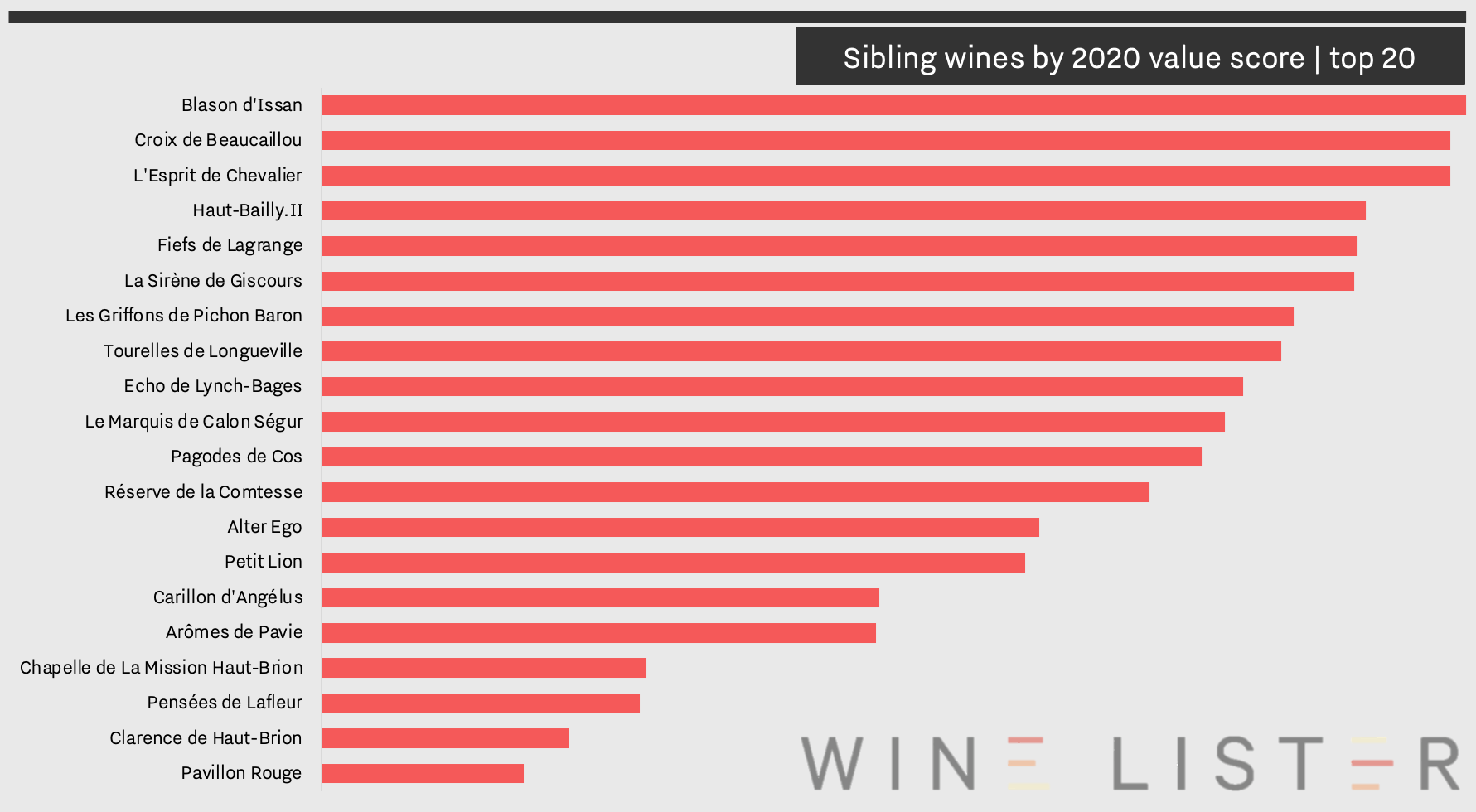 The top 20 leading sibling wines by Wine Lister value score
The top 20 leading sibling wines by Wine Lister value score
Which second wines provide the greatest value?
Often lurking in the shadows of their Grand Vin counterpart, sibling wines offer a high quality, more accessible alternative to Bordeaux’s long-ageing elite. While some are the product of grapes remaining from the Grand Vin, other producers prefer to give a sibling wine its own dedicated plots, often of slightly younger vines. In either case, these wines made at the hands of some of the world’s greatest winemakers should be considered seriously. Below we look at our top picks of sibling wines for value, based on the latest offerings from the Bordeaux 2020 en primeur campaign.
Left Bank legacies
All major Bordeaux appellations across both banks are well-represented amongst the top 20 value picks, with Margaux property, d’Issan achieving the greatest value score for the 2020 vintage. First produced in 1985, Blason d’Issan bears a greater proportion of Merlot than its Grand Vin sibling (57% compared to 39%), but as noted by its maker, Emmanuel Cruse, is still very much a “baby d’Issan”, sporting the château’s perennial style. The second wine of 2020’s wine of the vintage (according to Wine Lister partner critics), Margaux, has been a permanent feature of the estate since the 17th century; christened Pavillon Rogue in 1908, it is 2020’s only top 20 second wine from a First Growth property. Margaux comrade, Giscours, is also represented, by its Sirène de Giscours, which enjoys the same winemaking attention and ageing as the Grand Vin, but with grapes sourced from younger vines. Finally, Margaux majesty, Palmer is featured with Alter Ego. Its 2020 release was well sought-after, particularly after no second wine was produced in 2018.
Pessac-Léognan royalty, Haut-Brion’s Clarence de Haut-Brion ranks among the top 20 sibling wines for value. It is joined by L’Espirit de Chevalier – the red counterpart of Domaine de Chevalier’s sibling series – and Haut-Bailly’s Haut-Bailly II. The latter was renamed (from La Parde de Haut-Bailly) in 2019 to symbolise the second generation of owners, the Wilmers family. Finally, Chapelle de La Mission Haut Brion comes from the same vineyard as the Grand Vin, grown and harvested in the same way, with the introduction of grapes from the older parcels of La Tour Haut-Brion since the 2006 vintage.
Saint-Julien has three properties represented by their second wines, including Croix de Beaucaillou, which ranks in second place. This sibling wine is produced using grapes hailing from its own distinct vineyard, lying to the west of the château. Completing the top five rankings is Fiefs de Lagrange, which bears familiarity to its Grand Vin sibling, but is more suited for earlier drinking. Finally, Léoville Las Cases’ le Petit Lion celebrates its 13th vintage with the release of the 2020, produced from a blend of replanted vines that are now between 15 and 18 years of age.
In neighbouring Saint-Estèphe, Le Marquis de Calon Ségur and Pagodes de Cos occupy 10th and 11th place respectively, with the former taking very different form from their first wine as an alternative interpretation of the Calon terroir. The latter is produced from a separate, dedicated plot of 40-year-old vines.
Completing the Left Bank selection are four Pauillac value picks, of which two hail from the same property. Pichon Baron is the only property to see its two additional wines feature – Les Griffons de Pichon Baron and Tourelles de Longueville. Lynch-Bages’ Echo joins them within the top 10 picks by value score. Finally, Pichon Comtesse’s Réserve de la Comtesse – first sold in 1973 – is a top feature for en primeur 2020. This well-established sibling wine represents between 20% to 50% of Pichon Comtesse’s total production.
Right Bank relatives
One the Right Bank, and particularly in Pomerol, sibling wines have been slower to catch on, simply due to lower production levels per property. Two Saint Emilion Classés A properties nonetheless stand out for sibling value picks– Pavie and Angélus – featuring Arômes de Pavie and Carillon d’Angélus, respectively. The latter is increasingly becoming a “cousin” rather than a sibling, since the property has recently invested heavily in new plots for Carillon alone. Amongst this top pick hoard is Pomerol estate, Pensées de Lafleur, which takes 13th place amongst the top value picks with a limited-production of 500 cases.
As well as gaining top scores across its reds, Bordeaux 2020 was successful for dry whites, notably at the highest level. Helping you to discover some of the leading examples, we explore the top five Bordeaux 2020 dry white wines by WL score.
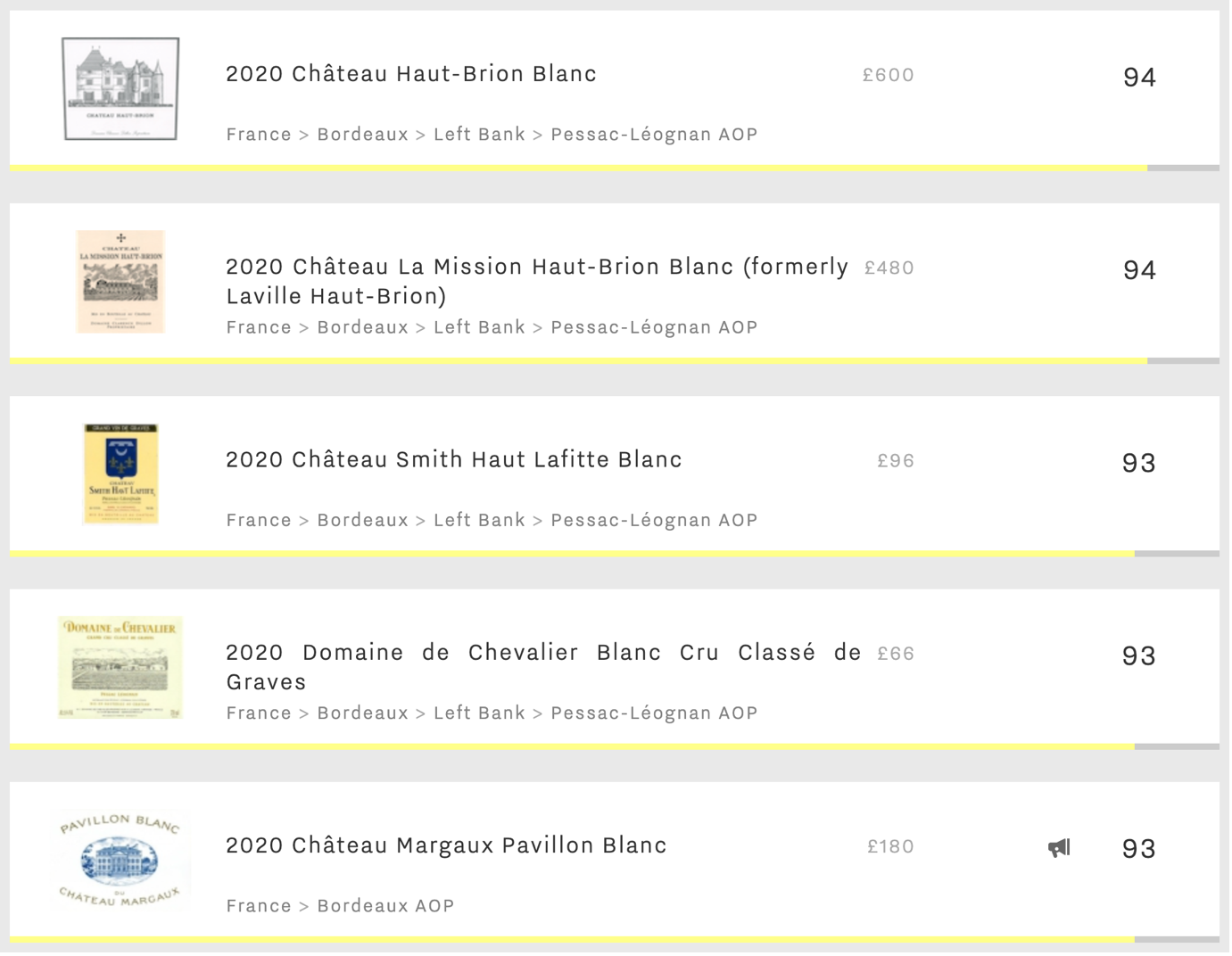 The top dry Bordeaux whites of the 2020 vintage, displayed in order of WL score
The top dry Bordeaux whites of the 2020 vintage, displayed in order of WL score
Will 2020 be a good vintage in Bordeaux for dry white wines?
Despite another exceedingly warm growing season in 2020, Bordeaux’s earlier-ripening white grapes fared well across many of the region’s top blanc producers. Having seen one of the earliest harvests on record, the first Sauvignon Blanc grapes were picked on the 14th of August, and all fruit destined for dry whites was harvested by early September. The white Bordeaux vintage therefore avoided high temperatures during the rest of the month, maintaining balance and freshness.
With a remarkably small production of just c.600 cases per annum, Haut-Brion Blanc remains one of the most sought-after Bordeaux dry whites. To combat the warm summer temperatures, the team conducted pre-dawn harvesting, picking grapes during the cooler night-time climate to ensure better levels of acidity and freshness. Wine Lister CEO, Ella Lister, found Haut-Brion Blanc to show “an almost Burgundian minerality accompanying its unmistakable Pessac green and yellow-fruit character”. With a WL score of 94, it champions the leader board of Bordeaux dry whites for the last four vintages, and there is still some of the 2020 available to purchase en primeur at IG Wines for £600 per bottle (in-bond).
Haut-Brion’s sibling estate, La Mission Haut-Brion’s white is characterised by a Sémillon-dominated blend – a grape with naturally low acidity compared to Bordeaux’s other white varietals. With soaring summer temperatures in 2020, the team therefore increased the percentage of Sauvignon Blanc in its blend to 54.7% (up from 30.1% in 2019) to ensure balance. Ella notes the impact of the increased Sauvignon on the wine’s acidity, describing a “zippy acidity, zingy energy, [with a] peach stone finish.” La Mission Haut-Brion’s white gains a WL score of 94 for the 2020 vintage, and can be found at Justerini & Brooks for £480 per bottle (in-bond).
Smith Haut Lafitte Blanc’s white vines are planted just behind the château to the north, where they benefit from a cooler microclimate that withstood high temperatures in 2020. Technical Director, Fabien Teitgen found a “nice balance and liveliness” in the grapes after harvest, while Ella characterises the 2020 as “subtle and flirtatious, building slowly into notes of white pepper and lime, as well as pure white fruit”. Gaining a WL score of 93, Smith Haut Lafitte blanc 2020 is available at Honest Grapes for £96 per bottle (in-bond).
Located at the heart of the Landes pine forest, Domaine de Chevalier’s vines are also subject to a cooler microclimate as a result of the surrounding woodland, which was certainly welcomed in 2020. When sampling the latest release at the estate, Ella enjoyed the richness of the vintage, noting “Aromas of tangerine, white flowers, custard, and acacia honey” and a palate that is “creamy and caressing […] with a lift of tension and a savoury bite.” Receiving a WL score of 93, Domaine de Chevalier Blanc 2020 can be acquired from Berry Bros & Rudd for £68 per bottle (in-bond).
Though First Growth Margaux has been producing a dry white for over 300 years, Pavillon Blanc 2020 marks the 100th anniversary under its current name. The only non-Pessac pick to feature in the top-five ranking, the success of the latest release was not without its challenges. Tasting alongside Margaux’s Managing Director, Philippe Bascaules, and Business Development Director, Alexis Leven-Mentzelopoulos, Ella was informed of the high mildew pressure as a result of a hot wet spring in 2020, which risked affecting the Sauvignon Blanc grapes of their single-varietal wine. Nevertheless, their 2020 receives a WL score of 93, with Ella describing a “Really rich, mouthcoating texture on entering the mouth – almost a Chardonnay-esque opulence”, and declaring the wine “Delicious.” Pavillon Blanc 2020 can be purchased en primeur from Goedhuis & Co for £180 per bottle (in-bond).
Bordeaux en primeur 2020 saw mixed pricing decisions throughout the campaign. To help those still looking to purchase en primeur this year, we examine some of the best offerings from the latest vintage at five different price points. (All prices are quoted in-bond per bottle when purchasing by the case).
Click here to view all Bordeaux 2020 releases, or read more below.
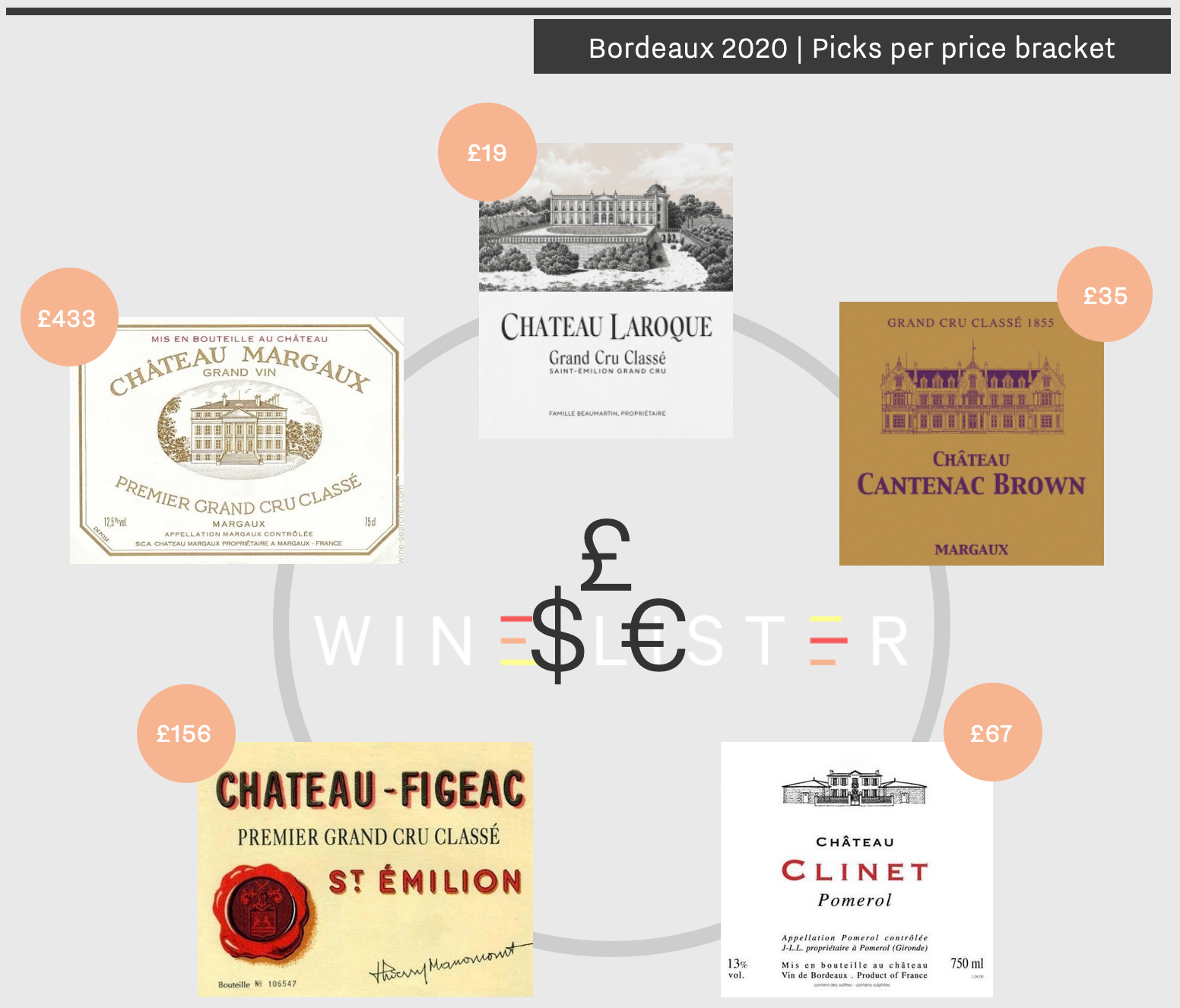
Under £20 – Laroque
Attesting to the estate’s sustained step-up in quality since its 2018 vintage, Laroque receives strong critical praise in 2020. Antonio Galloni and Neal Martin (Vinous) both award 93-95, with the latter calling it, “Possibly the best Laroque that winemaker Suire has overseen to date.” Having worked at fellow Saint-Émilion estates, Bellevue, Beauséjour Héritiers Duffau Lagarrosse, and Larcis Ducasse over the past 15 years, winemaker David Suire joined Laroque in 2015. He has since invested in making significant quality improvements, changing the winemaking process of the Grand Vin to now consist solely of free-run juice and no press wine. The third Laroque release in a row to achieve Value Pick status, the 2020 vintage can be bought from Justerini & Brooks for £18.92 per bottle (in-bond).
Under £50 – Cantenac Brown
The recent acquisition of Margaux Third Growth, Cantenac Brown, by agro-engineer, Tristan Le Lous, brought about a buzz of excitement for his first full vintage at the estate. Under its new ownership, the estate has expanded its vineyards by 9.5ha to incorporate high-quality vines from neighbouring estates, La Galiane and Charmant on the iconic Margaux plateau. Efforts to improve their blend, through the introduction of 70% of the grapes harvested on these new parcels, are reflected in top scores for the 2020 vintage, which receives its highest ever score from Antonio Galloni (94-97). Tasted by Wine Lister CEO, Ella Lister, she calls it, “A very successful Cantenac Brown.” Cantenac Brown 2020 can be purchased en primeur from Goedhuis for £34.33 per bottle (in-bond).
Under £100 – Clinet
Pomerol’s rising star, Clinet once again provides good value within its appellation in 2020. With traces of the vineyard dating back to 1595, one of Pomerol’s oldest estates is managed under the watchful eyes of a small team, co-headed by President of the UGCB, Ronan Laborde. Receiving a score of 94-96 from Neal Martin, he notes, “This is a Pomerol that really wants to make an impression.” Ella found the 2020 vintage to be, “Seamless and languorous. A triumph.” Clinet 2020 is available en primeur at IG Wines for £66.50 per bottle (in-bond).
Under £200 – Figeac
Completing a trilogy of top-scoring vintages, Figeac 2020 highlights the estate’s skilled adaptation to the extreme climate conditions it faced in the year. The team recently reflected on the challenges brought about by “mild winter temperatures, summer heat-waves, and unusually variable rainfall” in 2020, which nonetheless produced one of Ella’s favourite wines from the vintage. Tasting in Bordeaux, she notes a “Trademark Figeac texture. The harmony is mind-blowing.” This Saint-Émilion star can be purchased en primeur from Farr Vinters for £156 per bottle (in-bond).
Over £300 – Margaux
Margaux is one of Wine Lister’s top picks at the premium end of the en primeur spectrum. The highest-scoring wine of the vintage, Margaux is the only 2020 to receive a WL score of 98 (an average combining all Wine Lister’s partner critics on a 100-point scale). According to the Margaux team, the success of the vintage is down to the amalgamation of “homogenous flowering, summer conditions that favoured small berries, and excellent harvesting conditions.” Indeed, the 2020 receives a score of 19 from James Lawther for JancisRobinson.com, who describes it as the “Perfect pitch”, while Ella was “Wowed”, stating “This will age into eternity, and yet the texture is already soft now.” For those looking to find this First Growth, Margaux 2020 can be reserved for £433 per bottle (in-bond) via Petersham Nurseries.




 Teamwork amongst Tuscan vines: IPSUS (left), Tenuta San Guido (middle), Ornellaia (right)
Teamwork amongst Tuscan vines: IPSUS (left), Tenuta San Guido (middle), Ornellaia (right)
 A snapshot of this year’s harvest: Lafon-Rochet (far left), Palmer (middle left), d’Issan (middle right), and Smith Haut-Lafitte (far right)
A snapshot of this year’s harvest: Lafon-Rochet (far left), Palmer (middle left), d’Issan (middle right), and Smith Haut-Lafitte (far right)


 The top 20 leading sibling wines by Wine Lister value score
The top 20 leading sibling wines by Wine Lister value score
